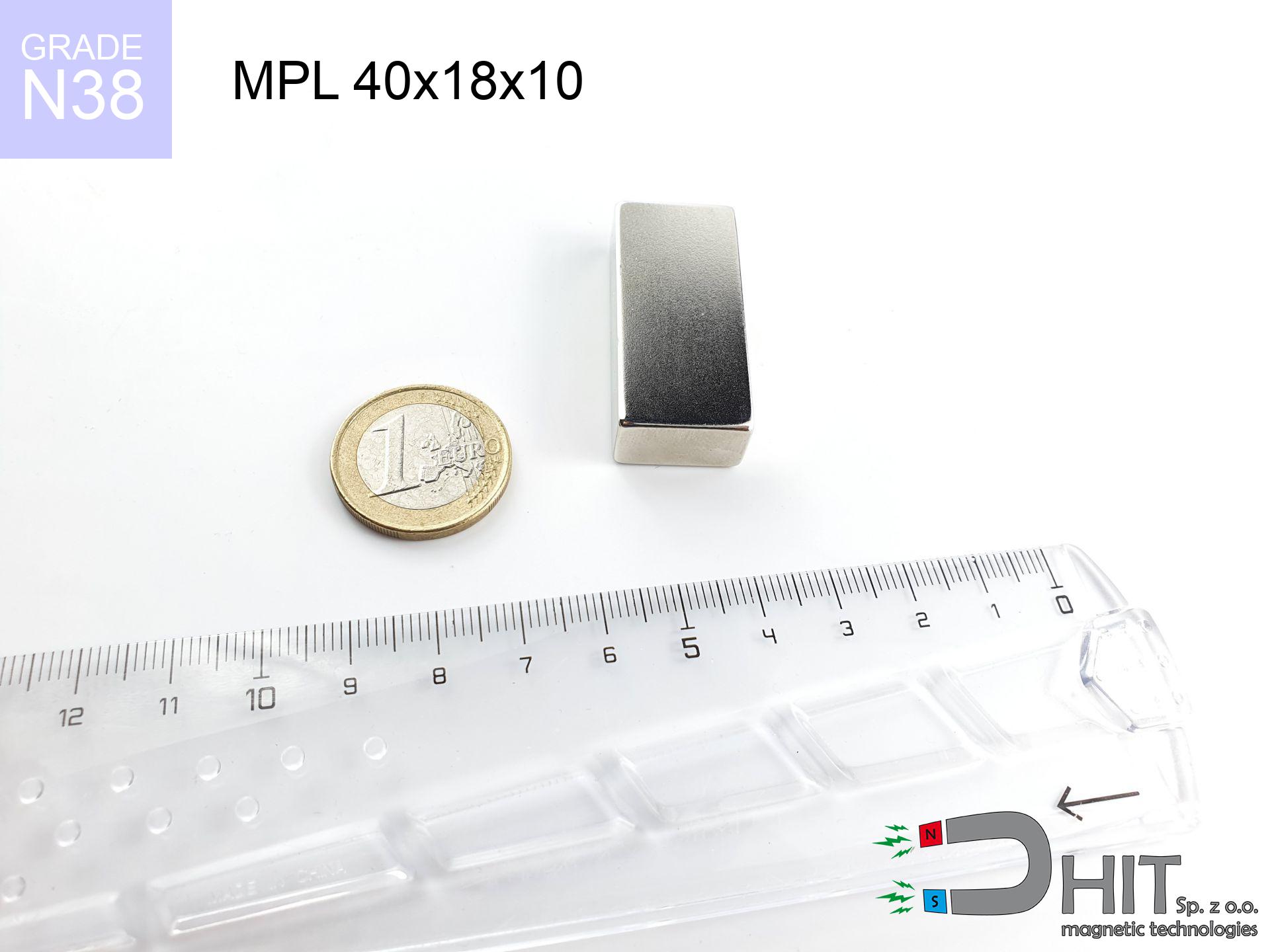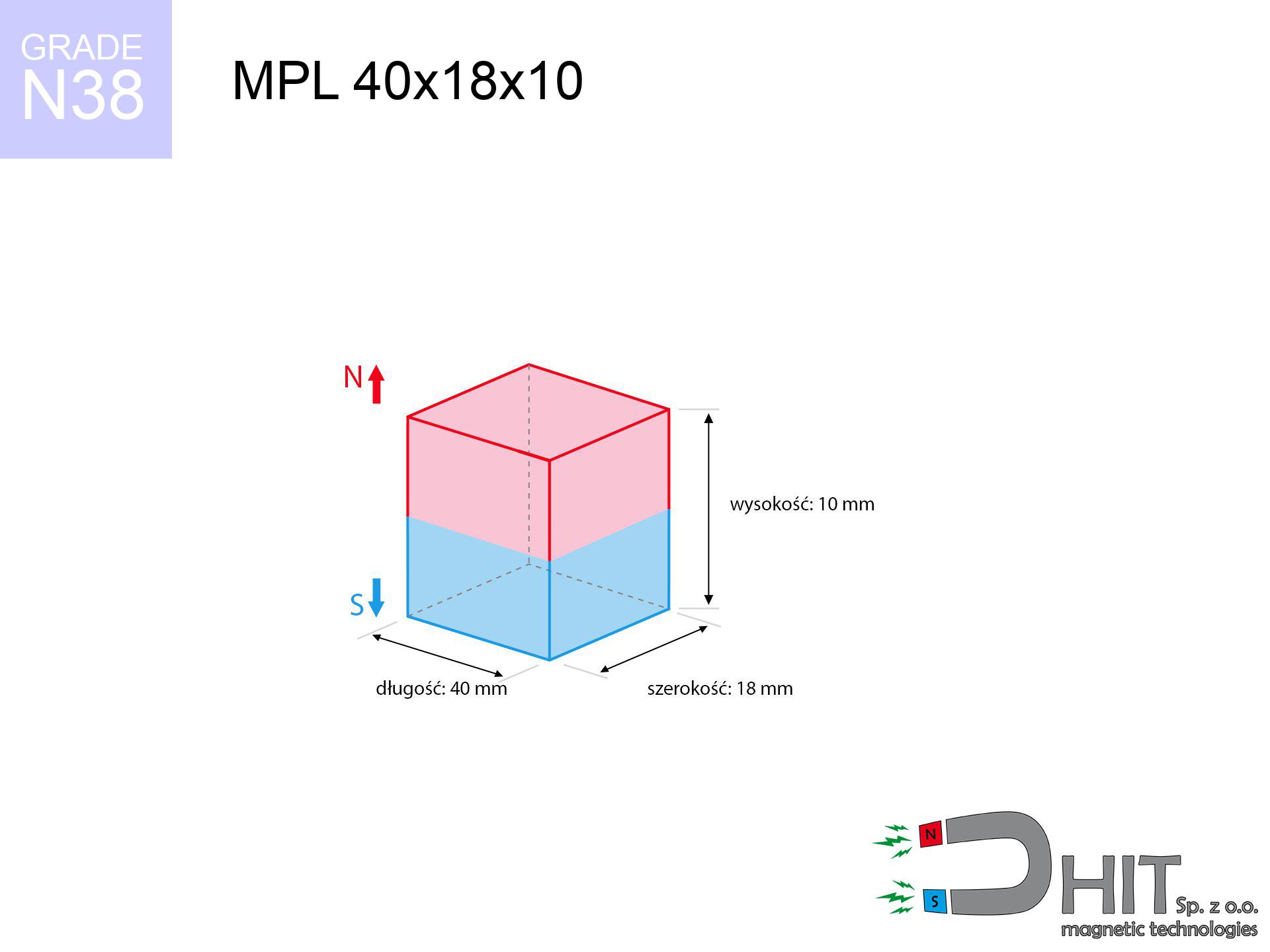MPL 40x18x10 / N38 - lamellar magnet
lamellar magnet
Catalog no 020156
GTIN/EAN: 5906301811626
length
40 mm [±0,1 mm]
Width
18 mm [±0,1 mm]
Height
10 mm [±0,1 mm]
Weight
54 g
Magnetization Direction
↑ axial
Load capacity
23.81 kg / 233.58 N
Magnetic Induction
366.66 mT / 3667 Gs
Coating
[NiCuNi] Nickel
30.75 ZŁ with VAT / pcs + price for transport
25.00 ZŁ net + 23% VAT / pcs
bulk discounts:
Need more?
Call us now
+48 22 499 98 98
alternatively let us know via
our online form
the contact form page.
Parameters along with form of a neodymium magnet can be tested with our
magnetic calculator.
Order by 14:00 and we’ll ship today!
Technical of the product - MPL 40x18x10 / N38 - lamellar magnet
Specification / characteristics - MPL 40x18x10 / N38 - lamellar magnet
| properties | values |
|---|---|
| Cat. no. | 020156 |
| GTIN/EAN | 5906301811626 |
| Production/Distribution | Dhit sp. z o.o. |
| Country of origin | Poland / China / Germany |
| Customs code | 85059029 |
| length | 40 mm [±0,1 mm] |
| Width | 18 mm [±0,1 mm] |
| Height | 10 mm [±0,1 mm] |
| Weight | 54 g |
| Magnetization Direction | ↑ axial |
| Load capacity ~ ? | 23.81 kg / 233.58 N |
| Magnetic Induction ~ ? | 366.66 mT / 3667 Gs |
| Coating | [NiCuNi] Nickel |
| Manufacturing Tolerance | ±0.1 mm |
Magnetic properties of material N38
| properties | values | units |
|---|---|---|
| remenance Br [min. - max.] ? | 12.2-12.6 | kGs |
| remenance Br [min. - max.] ? | 1220-1260 | mT |
| coercivity bHc ? | 10.8-11.5 | kOe |
| coercivity bHc ? | 860-915 | kA/m |
| actual internal force iHc | ≥ 12 | kOe |
| actual internal force iHc | ≥ 955 | kA/m |
| energy density [min. - max.] ? | 36-38 | BH max MGOe |
| energy density [min. - max.] ? | 287-303 | BH max KJ/m |
| max. temperature ? | ≤ 80 | °C |
Physical properties of sintered neodymium magnets Nd2Fe14B at 20°C
| properties | values | units |
|---|---|---|
| Vickers hardness | ≥550 | Hv |
| Density | ≥7.4 | g/cm3 |
| Curie Temperature TC | 312 - 380 | °C |
| Curie Temperature TF | 593 - 716 | °F |
| Specific resistance | 150 | μΩ⋅cm |
| Bending strength | 250 | MPa |
| Compressive strength | 1000~1100 | MPa |
| Thermal expansion parallel (∥) to orientation (M) | (3-4) x 10-6 | °C-1 |
| Thermal expansion perpendicular (⊥) to orientation (M) | -(1-3) x 10-6 | °C-1 |
| Young's modulus | 1.7 x 104 | kg/mm² |
Physical modeling of the magnet - data
Presented data represent the direct effect of a mathematical analysis. Results are based on models for the material Nd2Fe14B. Real-world performance might slightly differ from theoretical values. Treat these data as a preliminary roadmap for designers.
Table 1: Static force (pull vs gap) - power drop
MPL 40x18x10 / N38
| Distance (mm) | Induction (Gauss) / mT | Pull Force (kg/lbs/g/N) | Risk Status |
|---|---|---|---|
| 0 mm |
3666 Gs
366.6 mT
|
23.81 kg / 52.49 LBS
23810.0 g / 233.6 N
|
dangerous! |
| 1 mm |
3399 Gs
339.9 mT
|
20.48 kg / 45.14 LBS
20476.1 g / 200.9 N
|
dangerous! |
| 2 mm |
3120 Gs
312.0 mT
|
17.25 kg / 38.02 LBS
17245.9 g / 169.2 N
|
dangerous! |
| 3 mm |
2841 Gs
284.1 mT
|
14.30 kg / 31.54 LBS
14304.1 g / 140.3 N
|
dangerous! |
| 5 mm |
2321 Gs
232.1 mT
|
9.55 kg / 21.05 LBS
9547.8 g / 93.7 N
|
strong |
| 10 mm |
1370 Gs
137.0 mT
|
3.32 kg / 7.33 LBS
3324.4 g / 32.6 N
|
strong |
| 15 mm |
833 Gs
83.3 mT
|
1.23 kg / 2.71 LBS
1229.0 g / 12.1 N
|
weak grip |
| 20 mm |
530 Gs
53.0 mT
|
0.50 kg / 1.10 LBS
498.1 g / 4.9 N
|
weak grip |
| 30 mm |
244 Gs
24.4 mT
|
0.11 kg / 0.23 LBS
105.3 g / 1.0 N
|
weak grip |
| 50 mm |
75 Gs
7.5 mT
|
0.01 kg / 0.02 LBS
9.9 g / 0.1 N
|
weak grip |
Table 2: Slippage capacity (wall)
MPL 40x18x10 / N38
| Distance (mm) | Friction coefficient | Pull Force (kg/lbs/g/N) |
|---|---|---|
| 0 mm | Stal (~0.2) |
4.76 kg / 10.50 LBS
4762.0 g / 46.7 N
|
| 1 mm | Stal (~0.2) |
4.10 kg / 9.03 LBS
4096.0 g / 40.2 N
|
| 2 mm | Stal (~0.2) |
3.45 kg / 7.61 LBS
3450.0 g / 33.8 N
|
| 3 mm | Stal (~0.2) |
2.86 kg / 6.31 LBS
2860.0 g / 28.1 N
|
| 5 mm | Stal (~0.2) |
1.91 kg / 4.21 LBS
1910.0 g / 18.7 N
|
| 10 mm | Stal (~0.2) |
0.66 kg / 1.46 LBS
664.0 g / 6.5 N
|
| 15 mm | Stal (~0.2) |
0.25 kg / 0.54 LBS
246.0 g / 2.4 N
|
| 20 mm | Stal (~0.2) |
0.10 kg / 0.22 LBS
100.0 g / 1.0 N
|
| 30 mm | Stal (~0.2) |
0.02 kg / 0.05 LBS
22.0 g / 0.2 N
|
| 50 mm | Stal (~0.2) |
0.00 kg / 0.00 LBS
2.0 g / 0.0 N
|
Table 3: Wall mounting (sliding) - vertical pull
MPL 40x18x10 / N38
| Surface type | Friction coefficient / % Mocy | Max load (kg/lbs/g/N) |
|---|---|---|
| Raw steel |
µ = 0.3
30% Nominalnej Siły
|
7.14 kg / 15.75 LBS
7143.0 g / 70.1 N
|
| Painted steel (standard) |
µ = 0.2
20% Nominalnej Siły
|
4.76 kg / 10.50 LBS
4762.0 g / 46.7 N
|
| Oily/slippery steel |
µ = 0.1
10% Nominalnej Siły
|
2.38 kg / 5.25 LBS
2381.0 g / 23.4 N
|
| Magnet with anti-slip rubber |
µ = 0.5
50% Nominalnej Siły
|
11.91 kg / 26.25 LBS
11905.0 g / 116.8 N
|
Table 4: Steel thickness (saturation) - sheet metal selection
MPL 40x18x10 / N38
| Steel thickness (mm) | % power | Real pull force (kg/lbs/g/N) |
|---|---|---|
| 0.5 mm |
|
1.19 kg / 2.62 LBS
1190.5 g / 11.7 N
|
| 1 mm |
|
2.98 kg / 6.56 LBS
2976.3 g / 29.2 N
|
| 2 mm |
|
5.95 kg / 13.12 LBS
5952.5 g / 58.4 N
|
| 3 mm |
|
8.93 kg / 19.68 LBS
8928.7 g / 87.6 N
|
| 5 mm |
|
14.88 kg / 32.81 LBS
14881.3 g / 146.0 N
|
| 10 mm |
|
23.81 kg / 52.49 LBS
23810.0 g / 233.6 N
|
| 11 mm |
|
23.81 kg / 52.49 LBS
23810.0 g / 233.6 N
|
| 12 mm |
|
23.81 kg / 52.49 LBS
23810.0 g / 233.6 N
|
Table 5: Thermal stability (material behavior) - power drop
MPL 40x18x10 / N38
| Ambient temp. (°C) | Power loss | Remaining pull (kg/lbs/g/N) | Status |
|---|---|---|---|
| 20 °C | 0.0% |
23.81 kg / 52.49 LBS
23810.0 g / 233.6 N
|
OK |
| 40 °C | -2.2% |
23.29 kg / 51.34 LBS
23286.2 g / 228.4 N
|
OK |
| 60 °C | -4.4% |
22.76 kg / 50.18 LBS
22762.4 g / 223.3 N
|
|
| 80 °C | -6.6% |
22.24 kg / 49.03 LBS
22238.5 g / 218.2 N
|
|
| 100 °C | -28.8% |
16.95 kg / 37.37 LBS
16952.7 g / 166.3 N
|
Table 6: Magnet-Magnet interaction (attraction) - field range
MPL 40x18x10 / N38
| Gap (mm) | Attraction (kg/lbs) (N-S) | Sliding Force (kg/lbs/g/N) | Repulsion (kg/lbs) (N-N) |
|---|---|---|---|
| 0 mm |
59.64 kg / 131.49 LBS
5 034 Gs
|
8.95 kg / 19.72 LBS
8947 g / 87.8 N
|
N/A |
| 1 mm |
55.50 kg / 122.35 LBS
7 072 Gs
|
8.32 kg / 18.35 LBS
8325 g / 81.7 N
|
49.95 kg / 110.12 LBS
~0 Gs
|
| 2 mm |
51.29 kg / 113.08 LBS
6 799 Gs
|
7.69 kg / 16.96 LBS
7694 g / 75.5 N
|
46.16 kg / 101.77 LBS
~0 Gs
|
| 3 mm |
47.18 kg / 104.01 LBS
6 520 Gs
|
7.08 kg / 15.60 LBS
7076 g / 69.4 N
|
42.46 kg / 93.61 LBS
~0 Gs
|
| 5 mm |
39.41 kg / 86.88 LBS
5 959 Gs
|
5.91 kg / 13.03 LBS
5912 g / 58.0 N
|
35.47 kg / 78.20 LBS
~0 Gs
|
| 10 mm |
23.92 kg / 52.73 LBS
4 643 Gs
|
3.59 kg / 7.91 LBS
3588 g / 35.2 N
|
21.53 kg / 47.46 LBS
~0 Gs
|
| 20 mm |
8.33 kg / 18.36 LBS
2 739 Gs
|
1.25 kg / 2.75 LBS
1249 g / 12.3 N
|
7.49 kg / 16.52 LBS
~0 Gs
|
| 50 mm |
0.55 kg / 1.22 LBS
705 Gs
|
0.08 kg / 0.18 LBS
83 g / 0.8 N
|
0.50 kg / 1.09 LBS
~0 Gs
|
| 60 mm |
0.26 kg / 0.58 LBS
487 Gs
|
0.04 kg / 0.09 LBS
40 g / 0.4 N
|
0.24 kg / 0.52 LBS
~0 Gs
|
| 70 mm |
0.13 kg / 0.30 LBS
348 Gs
|
0.02 kg / 0.04 LBS
20 g / 0.2 N
|
0.12 kg / 0.27 LBS
~0 Gs
|
| 80 mm |
0.07 kg / 0.16 LBS
256 Gs
|
0.01 kg / 0.02 LBS
11 g / 0.1 N
|
0.07 kg / 0.14 LBS
~0 Gs
|
| 90 mm |
0.04 kg / 0.09 LBS
194 Gs
|
0.01 kg / 0.01 LBS
6 g / 0.1 N
|
0.04 kg / 0.08 LBS
~0 Gs
|
| 100 mm |
0.02 kg / 0.05 LBS
149 Gs
|
0.00 kg / 0.01 LBS
4 g / 0.0 N
|
0.02 kg / 0.05 LBS
~0 Gs
|
Table 7: Safety (HSE) (implants) - precautionary measures
MPL 40x18x10 / N38
| Object / Device | Limit (Gauss) / mT | Safe distance |
|---|---|---|
| Pacemaker | 5 Gs (0.5 mT) | 14.0 cm |
| Hearing aid | 10 Gs (1.0 mT) | 11.0 cm |
| Timepiece | 20 Gs (2.0 mT) | 8.5 cm |
| Phone / Smartphone | 40 Gs (4.0 mT) | 6.5 cm |
| Car key | 50 Gs (5.0 mT) | 6.0 cm |
| Payment card | 400 Gs (40.0 mT) | 2.5 cm |
| HDD hard drive | 600 Gs (60.0 mT) | 2.0 cm |
Table 8: Impact energy (kinetic energy) - warning
MPL 40x18x10 / N38
| Start from (mm) | Speed (km/h) | Energy (J) | Predicted outcome |
|---|---|---|---|
| 10 mm |
22.95 km/h
(6.38 m/s)
|
1.10 J | |
| 30 mm |
36.78 km/h
(10.22 m/s)
|
2.82 J | |
| 50 mm |
47.37 km/h
(13.16 m/s)
|
4.67 J | |
| 100 mm |
66.97 km/h
(18.60 m/s)
|
9.34 J |
Table 9: Corrosion resistance
MPL 40x18x10 / N38
| Technical parameter | Value / Description |
|---|---|
| Coating type | [NiCuNi] Nickel |
| Layer structure | Nickel - Copper - Nickel |
| Layer thickness | 10-20 µm |
| Salt spray test (SST) ? | 24 h |
| Recommended environment | Indoors only (dry) |
Table 10: Electrical data (Flux)
MPL 40x18x10 / N38
| Parameter | Value | SI Unit / Description |
|---|---|---|
| Magnetic Flux | 26 060 Mx | 260.6 µWb |
| Pc Coefficient | 0.43 | Low (Flat) |
Table 11: Underwater work (magnet fishing)
MPL 40x18x10 / N38
| Environment | Effective steel pull | Effect |
|---|---|---|
| Air (land) | 23.81 kg | Standard |
| Water (riverbed) |
27.26 kg
(+3.45 kg buoyancy gain)
|
+14.5% |
1. Shear force
*Warning: On a vertical wall, the magnet holds just ~20% of its nominal pull.
2. Efficiency vs thickness
*Thin steel (e.g. computer case) drastically limits the holding force.
3. Power loss vs temp
*For N38 material, the safety limit is 80°C.
4. Demagnetization curve and operating point (B-H)
chart generated for the permeance coefficient Pc (Permeance Coefficient) = 0.43
The chart above illustrates the magnetic characteristics of the material within the second quadrant of the hysteresis loop. The solid red line represents the demagnetization curve (material potential), while the dashed blue line is the load line based on the magnet's geometry. The Pc (Permeance Coefficient), also known as the load line slope, is a dimensionless value that describes the relationship between the magnet's shape and its magnetic stability. The intersection of these two lines (the black dot) is the operating point — it determines the actual magnetic flux density generated by the magnet in this specific configuration. A higher Pc value means the magnet is more 'slender' (tall relative to its area), resulting in a higher operating point and better resistance to irreversible demagnetization caused by external fields or temperature. A value of 0.42 is relatively low (typical for flat magnets), meaning the operating point is closer to the 'knee' of the curve — caution is advised when operating at temperatures near the maximum limit to avoid strength loss.
Elemental analysis
| iron (Fe) | 64% – 68% |
| neodymium (Nd) | 29% – 32% |
| boron (B) | 1.1% – 1.2% |
| dysprosium (Dy) | 0.5% – 2.0% |
| coating (Ni-Cu-Ni) | < 0.05% |
Sustainability
| recyclability (EoL) | 100% |
| recycled raw materials | ~10% (pre-cons) |
| carbon footprint | low / zredukowany |
| waste code (EWC) | 16 02 16 |
Other offers
Strengths as well as weaknesses of neodymium magnets.
Benefits
- They do not lose magnetism, even during around ten years – the drop in lifting capacity is only ~1% (according to tests),
- They show high resistance to demagnetization induced by external field influence,
- The use of an shiny coating of noble metals (nickel, gold, silver) causes the element to present itself better,
- The surface of neodymium magnets generates a intense magnetic field – this is one of their assets,
- Neodymium magnets are characterized by very high magnetic induction on the magnet surface and are able to act (depending on the form) even at a temperature of 230°C or more...
- Possibility of detailed machining as well as adapting to specific needs,
- Wide application in advanced technology sectors – they are commonly used in magnetic memories, drive modules, diagnostic systems, as well as modern systems.
- Relatively small size with high pulling force – neodymium magnets offer impressive pulling force in tiny dimensions, which enables their usage in compact constructions
Weaknesses
- To avoid cracks under impact, we recommend using special steel holders. Such a solution secures the magnet and simultaneously increases its durability.
- We warn that neodymium magnets can reduce their strength at high temperatures. To prevent this, we suggest our specialized [AH] magnets, which work effectively even at 230°C.
- Due to the susceptibility of magnets to corrosion in a humid environment, we advise using waterproof magnets made of rubber, plastic or other material resistant to moisture, when using outdoors
- Due to limitations in creating nuts and complicated forms in magnets, we propose using a housing - magnetic mechanism.
- Potential hazard resulting from small fragments of magnets pose a threat, if swallowed, which gains importance in the aspect of protecting the youngest. Additionally, small components of these products are able to complicate diagnosis medical when they are in the body.
- High unit price – neodymium magnets have a higher price than other types of magnets (e.g. ferrite), which increases costs of application in large quantities
Lifting parameters
Best holding force of the magnet in ideal parameters – what it depends on?
- with the application of a sheet made of low-carbon steel, guaranteeing full magnetic saturation
- possessing a thickness of min. 10 mm to ensure full flux closure
- with a surface free of scratches
- under conditions of ideal adhesion (metal-to-metal)
- for force applied at a right angle (pull-off, not shear)
- in stable room temperature
Magnet lifting force in use – key factors
- Clearance – existence of foreign body (paint, dirt, gap) acts as an insulator, which reduces capacity steeply (even by 50% at 0.5 mm).
- Force direction – note that the magnet holds strongest perpendicularly. Under shear forces, the holding force drops drastically, often to levels of 20-30% of the maximum value.
- Plate thickness – insufficiently thick sheet does not accept the full field, causing part of the power to be lost into the air.
- Steel grade – ideal substrate is pure iron steel. Hardened steels may have worse magnetic properties.
- Smoothness – ideal contact is obtained only on polished steel. Rough texture create air cushions, weakening the magnet.
- Thermal environment – heating the magnet causes a temporary drop of force. It is worth remembering the thermal limit for a given model.
Lifting capacity testing was carried out on plates with a smooth surface of suitable thickness, under perpendicular forces, however under shearing force the holding force is lower. In addition, even a small distance between the magnet’s surface and the plate decreases the lifting capacity.
Safety rules for work with NdFeB magnets
Allergic reactions
Certain individuals have a hypersensitivity to Ni, which is the standard coating for neodymium magnets. Extended handling can result in skin redness. It is best to wear protective gloves.
Physical harm
Big blocks can break fingers in a fraction of a second. Never put your hand between two attracting surfaces.
Precision electronics
An intense magnetic field negatively affects the operation of magnetometers in smartphones and GPS navigation. Keep magnets near a smartphone to avoid breaking the sensors.
Mechanical processing
Drilling and cutting of neodymium magnets carries a risk of fire risk. Neodymium dust oxidizes rapidly with oxygen and is hard to extinguish.
Magnet fragility
Protect your eyes. Magnets can explode upon uncontrolled impact, ejecting shards into the air. Eye protection is mandatory.
Respect the power
Before starting, check safety instructions. Uncontrolled attraction can destroy the magnet or hurt your hand. Be predictive.
Swallowing risk
Always keep magnets out of reach of children. Choking hazard is significant, and the effects of magnets connecting inside the body are tragic.
Electronic devices
Intense magnetic fields can corrupt files on credit cards, HDDs, and other magnetic media. Stay away of at least 10 cm.
Maximum temperature
Regular neodymium magnets (N-type) lose magnetization when the temperature surpasses 80°C. This process is irreversible.
Medical interference
Health Alert: Strong magnets can deactivate pacemakers and defibrillators. Stay away if you have electronic implants.





![UMGW 20x15x7 [M4] GW / N38 - magnetic holder internal thread UMGW 20x15x7 [M4] GW / N38 - magnetic holder internal thread](https://cdn3.dhit.pl/graphics/products/um-20x15x7-m4-gw-big.jpg)



